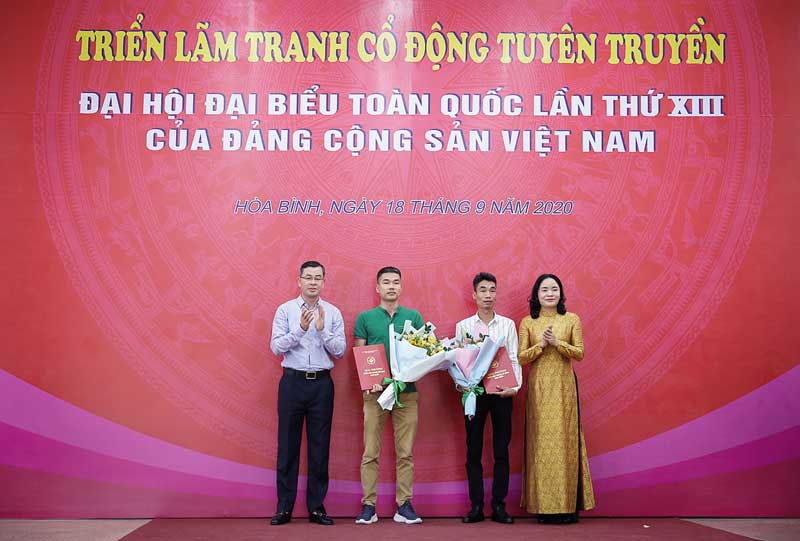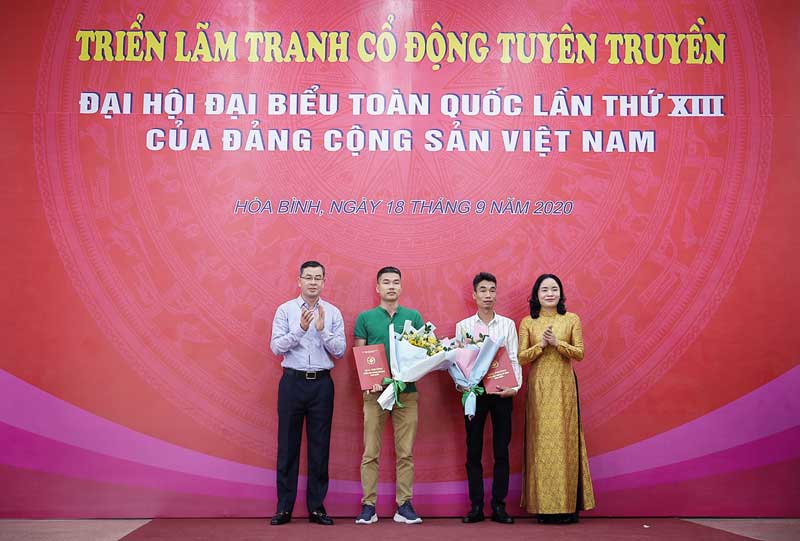
(HBO) – The Department of Grassroots Culture under the Ministry of Culture, Sports and Tourism in coordination with the Department of Culture, Sports and Tourism of Hoa Binh province on September 18 opened an exhibition of propaganda posters about the 13th National Party Congress and presented prizes to winners of poster design contests.
The opening ceremony in Hoa Binh city was attended by Deputy
Minister of Culture, Sports and Tourism Trinh Thi Thuy, Vice Secretary of the
provincial Party Committee Ngo Van Tuan, Vice Chairman of the provincial
People’s Committee Nguyen Van Chuong, officials from the Department of
Grassroots Culture and provincial agencies, and contest winners.
 Deputy Minister of Culture, Sports and Tourism Trinh
Thi Thuy and Vice Secretary of the provincial Party Committee Ngo Van Tuan
present two first prizes of the poster design contests.
Deputy Minister of Culture, Sports and Tourism Trinh
Thi Thuy and Vice Secretary of the provincial Party Committee Ngo Van Tuan
present two first prizes of the poster design contests.
The propaganda poster design contest on the
Party and political system building and the 13th National Party Congress was
opened for entries from June 1 to July 16, attracting 405 posters by 160
designers from 46 provinces and cities nationwide.
The competition of posters about the 75th
anniversary of the August Revolution and the 75th National Day from April 16 to
June 22 received 388 entries by 276 designers from 50 provinces and cities.
In these two contests, the judging panels
selected two entries for the first prizes, four for second prizes, six for
third prizes, and 20 for consolation prizes. As many as 140 high-quality
posters were also chosen for display and use in localities nationwide.
The exhibition of propaganda posters about the 13th National
Party Congress in Hoa Binh city showcases 50 outstanding ones among entries
submitted to the two competitions. The exhibits are considered an effective
channel for helping local cadres, Party members and people, especially the youth,
to learn more about the Party’s glorious history, traditions and achievements,
along with late President Ho Chi Minh’s thought, morality and life style, in
the struggle for national independence and the course of national development
and defence./.
With an increasingly vibrant and widespread emulation movement aimed at building cultured residential areas and cultured families, Yen Thuy District has been making steady progress toward improving both the material and spiritual well-being of its people, while fostering a civilized, prosperous, beautiful, and progressive community.
Once lacking recreational spaces and community facilities, Residential Group 2 in Quynh Lam Ward (Hoa Binh City) has recently received attention for the construction of a new, spacious, and fully equipped cultural house. The project followed the model of state support combined with public contributions in both labor and funding.
The "All people unite to build cultural life" movement, which has been effectively integrated with Kim Boi district’s socio-economic development goals, is fostering a lively spirit of emulation across local residential areas, hamlets, villages, public agencies, and enterprises. In addition, through the initiative, traditional cultural values are being preserved and promoted, while community solidarity and mutual support in poverty reduction and economic development are being strengthened.
A working delegation of the Hoa Binh provincial People’s Committee led by its Permanent Vice Chairman Nguyen Van Toan on June 11 inspected the progress of a project to build the Mo Muong Cultural Heritage Conservation Space linked to tourism services in Hop Phong commune, Cao Phong district.
Born and growing in the heroic land of Muong Dong, Dinh Thi Kieu Dung, a resident in Bo town of Kim Boi district, in her childhood was nurtured by the sweet lullabies of her grandmother and mother. These melodies deeply imprinted on her soul, becoming an inseparable part of her love for her ethnic group's culture. For over 20 years, this love for her hometown has driven Dung to research, collect, and pass down the cultural values of the Muong people to future generations.
In the final days of May, the Ethnic Art Troupe of Hoa Binh Province organized performances to serve the people in remote, mountainous, and particularly disadvantaged areas within the province. These were not just ordinary artistic shows, but they were the meaningful journeys aimed at spreading cultural values, enhancing the spiritual life of the people and contributing to the preservation of ethnic minority cultural identities.



 Deputy Minister of Culture, Sports and Tourism Trinh
Thi Thuy and Vice Secretary of the provincial Party Committee Ngo Van Tuan
present two first prizes of the poster design contests.
Deputy Minister of Culture, Sports and Tourism Trinh
Thi Thuy and Vice Secretary of the provincial Party Committee Ngo Van Tuan
present two first prizes of the poster design contests.